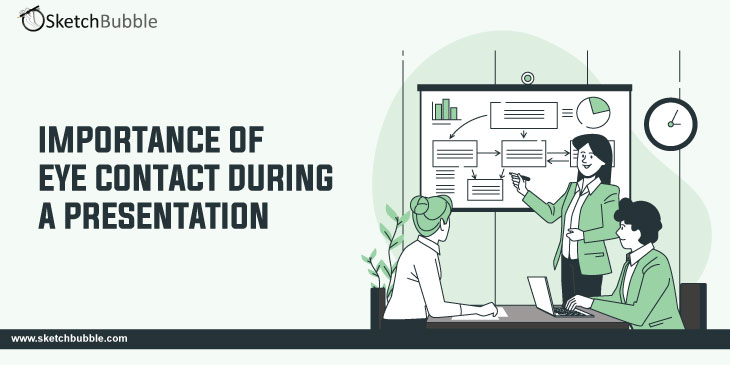
Let’s assume a scenario! You are not feeling well and consulted two doctors to overcome your illness. The first doctor projected himself calm and maintained appropriate eye contact while telling you about your illness and treatment plan. Contrary to this, the second doctor portrayed himself as edgy and reluctant to make eye contact. Whose advice and treatment would you prefer to follow? Well, we are pretty sure that you would follow the advice of Doctor No. 1! It’s not that the second doctor has no knowledge about that specific ailment or is not qualified; the only thing that made a huge difference is – eye contact!
Effective and meaningful eye contact is indispensable when it comes to public speaking. Maintaining eye contact with the audience while delivering your speech gives them a sense of involvement and keeps them engaged. Oppositely, lack of eye contact signifies nervousness, shyness, and lack of confidence.
In this blog post, we have discussed how eye contact can help you ace your presentations. Read on!
1. Converts Your Talk into Conversation
Which conversation/discussion made by your project head will you better retain – the one made over a phone call or the one made on a video call? Well, you are most likely to understand the conversation made over a video call as the eye contact established by your project head during the interaction will increase your remembrance.
Appropriate eye contact helps the presenter create an emotional bond and increase empathy with the audience. Furthermore, it will enhance their interest in your presentation, making them quickly interpret and absorb the information shared by you. In addition, this nonverbal form of communication increases your persuasive power and aids you in portraying how much you care about the viewpoints and thoughts of the audience.
2. Projects Confidence and Authority
Would you trust the advice of a wealth manager who feels hesitant to meet your gauge? Or would you prefer to buy a product from a salesperson who does not look at you while telling you about the product features? You won’t, right?
Looking the audience members in their eyes while delivering your talk lets you project your authority, assertiveness, confidence, conviction, and self-esteem and make them believe in your ideas and agree with your viewpoints. Moreover, when you use eye contact correctly, you are perceived as knowledgeable and expert in your subject/field.
3. Calms Your Nerves and Improves Concentration
When you focus your eyes on different audience members, your nervousness automatically gets reduced, and your brain starts concentrating on what you are saying. You shift your mind from self-consciousness to your listeners’ responses and direct your energy towards making your presentation memorable. You slow down and speak at a natural pace to make the audience understand your core message. You tend to adjust your speech delivery according to the cues you receive from the audience.
4. Transforms Passive Listeners to Active Participants
With the availability of technology at our fingertips and a lot of other distractions around, it is quite easy for your audience to lose their concentration. You can get back their focus by making eye contact with them.
The audience members feel invited to engage with you on a personal level, listen to you with undivided attention, and participate in your conversation when they see your eyes scanning their faces. They feel inspired to respond to what you are saying with frowns, nods, smiles, and other facial expressions or gestures. Ultimately, they develop a deeper connection and positive feeling of trust with your words and turn into active participants.
Quick Tips to Improve Eye Contact
- Establish eye contact before you start speaking.
- Look at each person if you are speaking to a small audience. And if you are speaking to a large audience, it’s not possible to look at every one. In such a scenario, you can look at the audience sitting at the front, middle and back sides of the room.
- The meaning/sense of eye contact differs by culture. For example, in Asian culture, if a subordinate makes eye contact with a superior, it indicates a sign of disrespect. In the Middle East, eye contact between people of the opposite gender is considered inappropriate. As a presenter, you must have an understanding of the cultural behavior and norms of your audience members.
- Do not stare or look aggressively at audience members as it might make them uncomfortable. Don’t maintain eye contact with any audience member for more than 4-5 seconds.
- Do not break eye contact and look away too quickly, as it will make you appear shy or nervous.
The Inference
“Where words are restrained, the eyes often talk a great deal.” – Samuel Richardson
The eyes are the most mysterious and precious organ of the human body that non-verbally communicate many things, such as affection, interest, attraction, confidence, sincerity, hostility, and much more. This organ has an important role in the presentation, which every presenter must understand and acknowledge. The meaningful eye contact accompanied by insightful words helps you build a good rapport with the audience and can be a game-changer for your presentations. Further, eye contact is essential to maintain the flow of conversation and appraise the audience’s response and interest.
Remember that maintaining good eye contact is a skill that can be improved and fine-tuned with practice. You can develop better eye contact skills by practicing yourself using a mirror, having a staring contest with a friend, noticing the eye contact of people with great social skills, and practicing eye contact while talking to strangers.
Hope you find the blog post informative and useful. Leave your response in the ‘comment’ section below. And if you like the blog post, do share it on your social handles.



